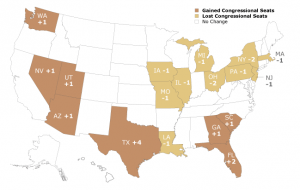Political Action for Latinos will be in State Legislatures
Now that the reading of the Constitution is done the members of the US Congress can get to the work of little else.
I’m not criticizing the political theater of the first few days of the new session of congress; I would never disrespect the constitution. I just don’t expect much else from Washington in the next 12 months. My bet is on the politics at the state level. That’s where all the action is going to be. Three things to keep an eye out for in the state houses: budget, immigration and redistricting-not particularly in that order.
The Pew Hispanic Center just released their findings regarding population and congressional reapportionment. You’ll be nodding when you read this:
“Hispanic voters are nearly three times more prevalent in states that gained congressional seats and Electoral College votes in the 2010 reapportionment than they are in states that lost seats.
Based on averages reflecting congressional gains and losses, 15.2% of the eligible voter population in states that gained seats is Hispanic, compared with just 5.4% of eligible voters in those states that lost seats.”
The battles over reapportionment will be in the specific states that gained congressional seats: Washington (1), Nevada (1), Utah (1), Arizona (1), Texas (4), Georgia (1), South Carolina (1) and Florida (2). Here’s a more detailed Pew Hispanic Center map:
The things to look out for are: Who are the champions in those battles? Will Latino voting influence remain intact? (Voter influence can be diluted by the mere stroke of a district-line pen.) I don’t trust this process. Too much is at stake and too few people have a say in how things turn out. This whole reapportionment thing is more horse-trading than statesmanship. There are organizations, though, that are intent on making the process as transparent as possible. We’ll be doing our part to draw the curtains because it’s not just about the politics of this year:
“Since 2000, nearly 6 million more Latinos have become eligible to vote. The bulk of this growth was attributable to the 5 million U.S. born Latino youths nationwide who turned 18 during this past decade. That translates into an additional half-million U.S. born Latinos coming of age each year-a pattern that is certain to persist, and grow, in the coming decades.”


